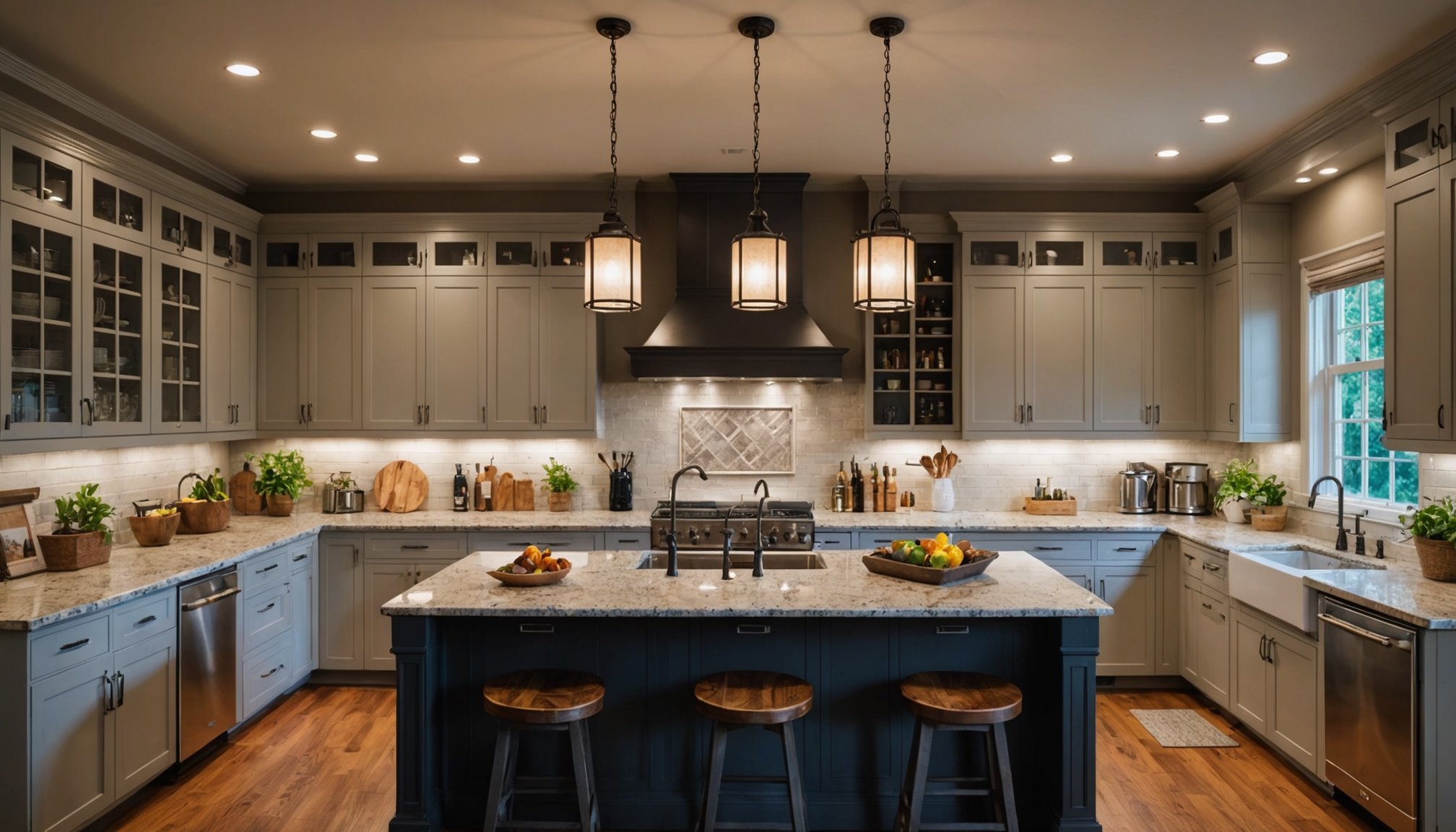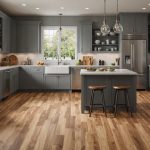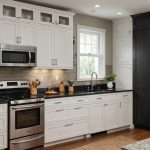Importance of Kitchen Lighting
Adequate kitchen lighting plays a crucial role in enhancing both the functionality and the aesthetic appeal of your kitchen. A well-lit kitchen contributes significantly to a space’s efficiency, supporting tasks like chopping, cooking, and cleaning. This functional lighting ensures safety and precision in food preparation, minimizing accidents and missteps.
Lighting also has a profound emotional impact on your cooking and dining experience. A thoughtful combination of lighting can create a cozy atmosphere, making the space inviting for both casual meals and elaborate dinners. The right lighting choices can evoke warmth and relaxation, transforming your kitchen into a hub of comfort and conviviality.
This might interest you : Discover the Best Anti-Fatigue Flooring Options for a Comfortable Cooking Experience in Your Small Kitchen
Design coherence is another aspect where lighting proves essential. By selecting fixtures that complement cabinetry and decor, you can craft a unified look that ties the kitchen together harmoniously. Opt for lighting solutions that flatter the room’s architectural highlights and color schemes, facilitating a seamless blend of style and functionality.
In summary, kitchen lighting does more than illuminate—it enhances usability, influences mood, and fortifies design continuity. By refining your kitchen lighting strategy, you’ll transform your culinary space into an area that supports efficiency and welcomes warmth.
Also to discover : Revitalize your kitchen: discover how a built-in composting unit can minimize food waste and foster a sustainable lifestyle
Types of Kitchen Lighting Fixtures
The selection of kitchen light fixtures is crucial for both aesthetic appeal and functionality within a kitchen. Among popular choices are pendant lights, which not only provide illumination but also serve as a focal point. These fixtures can vary in style, adding visual interest and serving as effective task lighting over dining areas or kitchen islands. When hanging pendant lights, consider the height for optimal lighting and prevent any obstructive views.
On the other hand, overhead lighting options like recessed lights offer a broad range of styles and effects. These fixtures are ideal for providing even and efficient general lighting. Their concealed nature ensures they seamlessly integrate with the kitchen’s design. Overhead lighting can be adapted to suit various kitchen sizes and layouts, enhancing overall ambiance.
Under-cabinet lighting is integral for improving visibility on countertops and workspaces. It eliminates shadows in areas where precision is necessary, like chopping or measuring. This lighting type can be particularly beneficial for task-driven spaces, offering both practical illumination and a touch of modern elegance. Installation of under-cabinet lighting is relatively simple, making it a popular choice for those seeking to enhance the workspace without extensive modifications.
Lighting Styles to Consider
Selecting the right kitchen light fixtures involves considering styles that align with your kitchen’s overall design. For a contemporary kitchen, integrating modern lighting enhances sleek aesthetics with polished metallics and clean lines. These elements deliver both elegance and utility, making them suitable for a minimalistic space. However, combining modern fixtures with pieces from a rustic design introduces an eclectic look that balances warmth and sophistication. A popular approach is to mix materials like wood and metal for a visually captivating interplay.
When choosing fixtures, it is essential to think about their ability to complement cabinetry and décor. Opt for lighting that either accentuates or subtly harmonizes with the existing elements of your kitchen. For example, pendant lights with a warm wood trim may complement rustic cabinets, while glass shades may enhance modern polished surfaces.
Consider the kitchen’s existing color palette and architectural features to ensure light fixtures contribute to design cohesion. A careful selection of styles can elevate the room’s aesthetic without overwhelming it. Additionally, integrating varied fixture designs in a single kitchen requires strategic placement to maintain a balanced visual impact. Thoughtful coordination will allow you to achieve a uniquely personalized and inviting kitchen atmosphere.
Ambient, Task, and Accent Lighting
In a well-designed kitchen, harnessing ambient lighting, task lighting, and accent lighting creates a layered, versatile lighting scheme.
Defining Ambient Lighting
Ambient lighting serves as the primary light source, providing broad illumination that covers the entire kitchen space. It establishes the base level of lighting, making the space welcoming and navigable. Common options include overhead fixtures or recessed lights, both of which offer uniformity and consistency.
Utilizing Task Lighting Effectively
For precision tasks like chopping or reading recipes, task lighting is critical. It focuses on specific areas where additional brightness is needed, ensuring accuracy and safety. Consider integrating under-cabinet lights or hanging pendant lights over countertops and islands to optimise workspace visibility. This type of lighting is direct and functional, supporting everyday kitchen activities with clarity.
Enhancing with Accent Lighting
Adding dimension to your kitchen is made possible with accent lighting. This type of lighting highlights architectural features or decorative elements, creating visual interest. Smaller fixtures or LED strips can be installed above cabinets or within display shelves. Accent lighting acts as a tool to enhance aesthetics, crafting focal points that enrich the kitchen’s ambience. Leveraging these lighting layers creates a harmonious environment suited for diverse culinary and social activities.
Practical Installation Tips
When contemplating lighting installation in the kitchen, it is essential to prioritise safety and efficiency, striking a balance between DIY endeavours and professional intervention. For those with basic electrical knowledge, DIY lighting projects can offer a sense of accomplishment and cost savings. Before undertaking such tasks, ensure that you switch off the power supply to avoid accidents, using insulated tools, and follow electrical codes and guidelines meticulously.
Consider professional lighting tips when dealing with more complex installations or reconfiguring the kitchen’s wiring. Hiring an expert ensures compliance with electrical safety standards and precise fixture placement, preventing future issues. Professionals can also provide insights into modern fixtures and configurations, enhancing both functionality and aesthetics.
To enhance your kitchen lighting without significant renovations, explore cost-effective upgrades. Opt for LED lights that offer longevity and energy efficiency, reducing utility costs. Another simple yet effective update involves replacing old fixtures with more contemporary designs, instantly refreshing the kitchen ambiance. Under-cabinet lights or adhesive LED strips are excellent for updating workspace lighting without extensive wiring changes.
By combining these lighting installation strategies, you can enhance your kitchen’s functionality and mood, tailoring it to meet both practical and aesthetic needs.
Balancing Ambiance and Functionality
Creating a balance between kitchen ambiance and functionality is pivotal in lighting design. For a warm and inviting atmosphere, consider using light fixtures that diffuse soft light, contributing to a cozy atmosphere. Incorporate elements like warm-tone bulbs or dimmable lights to adjust intensity according to the time of day or occasion.
Creating a Warm Atmosphere
To enhance the feeling of warmth, focus on integrating functional lighting tips that add both comfort and efficiency. Ambient lighting combined with strategic placement of accent lights can emphasize architectural details or highlight artwork, fostering a welcoming environment.
Multi-functional Uses of Lighting
Kitchens serve multiple roles, and your lighting should reflect this versatility. Install task lights that cater to specific activities like food prep and socialize under atmospheric lights without needing to shift fixtures. By doing so, you support both precision and relaxation, contributing to an effective kitchen space that meets diverse needs.
Importance of Dimming Options
The ability to tweak light intensity through dimmers offers flexibility and control in achieving the desired lighting design balance. Dimmers also contribute to energy savings by reducing power usage when full brightness is unnecessary. They are a practical addition for those looking to maximise the functionality and ambiance of their kitchen lighting.








